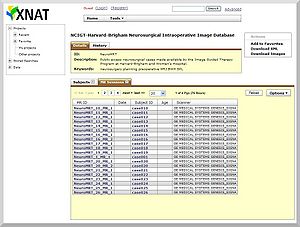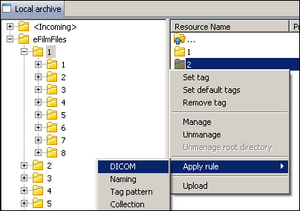Difference between revisions of "Engineering:WUSTL"
| (12 intermediate revisions by 2 users not shown) | |||
| Line 8: | Line 8: | ||
seamless integration between our tools and the other components in the NA-MIC kit. | seamless integration between our tools and the other components in the NA-MIC kit. | ||
| + | |||
| + | [[image:xnat-enterprise.jpg|thumb|left|300px|XNAT Enterprise]] | ||
| + | [[image:xnat-desktop.png|thumb|left|300px|XNAT Desktop]] | ||
= Wash U Projects = | = Wash U Projects = | ||
| − | |||
| − | |||
| − | |||
| − | |||
| − | |||
| − | |||
| − | |||
| − | |||
| − | |||
| − | |||
| − | |||
| − | |||
| − | |||
| − | |||
| − | |||
| − | |||
| − | |||
| − | |||
== [http://www.xnat.org XNAT Enterprise] == | == [http://www.xnat.org XNAT Enterprise] == | ||
| − | XNAT is an open source | + | XNAT is an open source imaging informatics platform designed to facilitate management and exploration of biomedical imaging and related data. XNAT includes a secure database backend and a rich web-based user interface. XNAT 1.4 was released in May, 2010. A more detailed description of XNAT can be found [http://www.xnat.org here]. |
| − | + | Within the scope of NA-MIC, we are focusing on implementing a robust API for accessing image resources, including raw DICOM and a variety of other formats including NIFTI and NRRD. Slicer will be coded to use this API for intereacting with XNAT repositories. The API will support a typical Slicer workflow which would include: | |
| + | * querying for patients by various metadata | ||
| + | * downloading desired patient studies into Slicer | ||
| + | * manipulating the images in Slicer, | ||
| + | * uplodaing the manipulated images back to the XNAT repository | ||
<hr> | <hr> | ||
| Line 39: | Line 28: | ||
== [http://nrg.wustl.edu/xnd/xnd_tutorial.html XNAT Desktop] == | == [http://nrg.wustl.edu/xnd/xnd_tutorial.html XNAT Desktop] == | ||
| − | XNAT Desktop (XND) is a desktop application for organizing, sharing, and distributing imaging and related files. It is operating system-independent, easily installed, and has no external dependencies. XND can be used to tag and upload data to XNAT Enterprise systems and to streamline workflows that utilize Slicer and other components of the NA-MIC Kit. XND includes a built-in web server that allows it to act as a file server using the same REST [http://nrg.wikispaces.com/XNAT+Web+Services+API web services API] that is being implemented for XNAT Enterprise [http:// | + | XNAT Desktop (XND) is a desktop application for organizing, sharing, and distributing imaging and related files. It is operating system-independent, easily installed, and has no external dependencies. XND can be used to tag and upload data to XNAT Enterprise systems and to streamline workflows that utilize Slicer and other components of the NA-MIC Kit. XND includes a built-in web server that allows it to act as a file server using the same REST [http://nrg.wikispaces.com/XNAT+Web+Services+API web services API] that is being implemented for XNAT Enterprise [http://www.xnat.org/xnd/ More...] |
| + | |||
| + | XND will allow Slicer users to maintain local repositories of their data which will be fully integrated with enterprise XNAT systems. | ||
<hr> | <hr> | ||
| Line 45: | Line 36: | ||
== [http://central.xnat.org XNAT Central] == | == [http://central.xnat.org XNAT Central] == | ||
| − | XNAT Central is a free, publicly accessible instance of the XNAT Enterprise system. It supports MRI, PET, CT, and a range of other imaging modalities. Researchers are invited to use XNAT Central to share their imaging studies with select colleagues or as open access projects under one of several licenses (public domain, creative commons, etc). | + | XNAT Central is a free, publicly accessible instance of the XNAT Enterprise system. It supports MRI, PET, CT, and a range of other imaging modalities. Researchers are invited to use XNAT Central to share their imaging studies with select colleagues or as open access projects under one of several licenses (public domain, creative commons, etc). [http://central.xnat.org More...] |
| − | |||
| − | |||
| − | + | XNAT Central currently hosts a number of NA-MIC data sets, as described [http://www.na-mic.org/Wiki/index.php/Downloads here]. | |
| − | |||
<hr> | <hr> | ||
Latest revision as of 22:04, 3 June 2014
Home < Engineering:WUSTLBack to NA-MIC Engineering
Overview of Washington University Projects (PI: Dan Marcus)
The Neuroinformatics Research Group at Washington University is responsible for developing desktop and enterprise level data management software for research imaging studies. We work in close collaboration with Core 1 engineering investigators to implement seamless integration between our tools and the other components in the NA-MIC kit.
Wash U Projects
XNAT Enterprise
XNAT is an open source imaging informatics platform designed to facilitate management and exploration of biomedical imaging and related data. XNAT includes a secure database backend and a rich web-based user interface. XNAT 1.4 was released in May, 2010. A more detailed description of XNAT can be found here.
Within the scope of NA-MIC, we are focusing on implementing a robust API for accessing image resources, including raw DICOM and a variety of other formats including NIFTI and NRRD. Slicer will be coded to use this API for intereacting with XNAT repositories. The API will support a typical Slicer workflow which would include:
- querying for patients by various metadata
- downloading desired patient studies into Slicer
- manipulating the images in Slicer,
- uplodaing the manipulated images back to the XNAT repository
XNAT Desktop
XNAT Desktop (XND) is a desktop application for organizing, sharing, and distributing imaging and related files. It is operating system-independent, easily installed, and has no external dependencies. XND can be used to tag and upload data to XNAT Enterprise systems and to streamline workflows that utilize Slicer and other components of the NA-MIC Kit. XND includes a built-in web server that allows it to act as a file server using the same REST web services API that is being implemented for XNAT Enterprise More...
XND will allow Slicer users to maintain local repositories of their data which will be fully integrated with enterprise XNAT systems.
XNAT Central
XNAT Central is a free, publicly accessible instance of the XNAT Enterprise system. It supports MRI, PET, CT, and a range of other imaging modalities. Researchers are invited to use XNAT Central to share their imaging studies with select colleagues or as open access projects under one of several licenses (public domain, creative commons, etc). More...
XNAT Central currently hosts a number of NA-MIC data sets, as described here.

